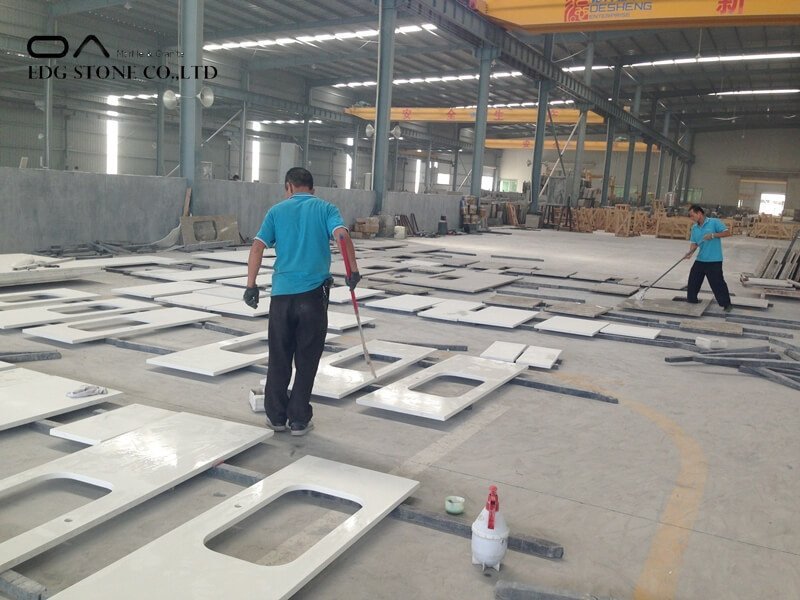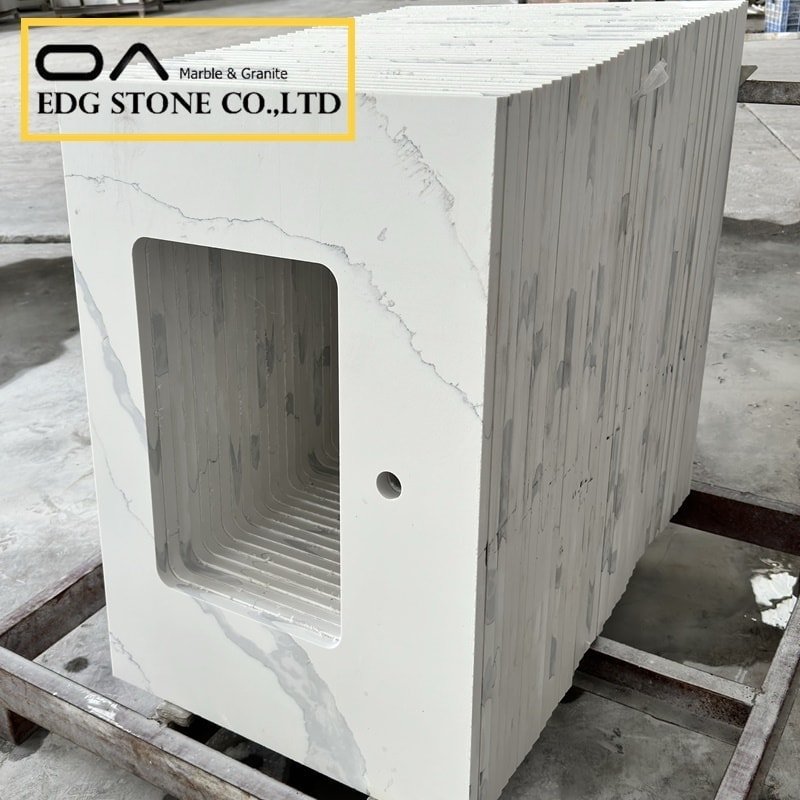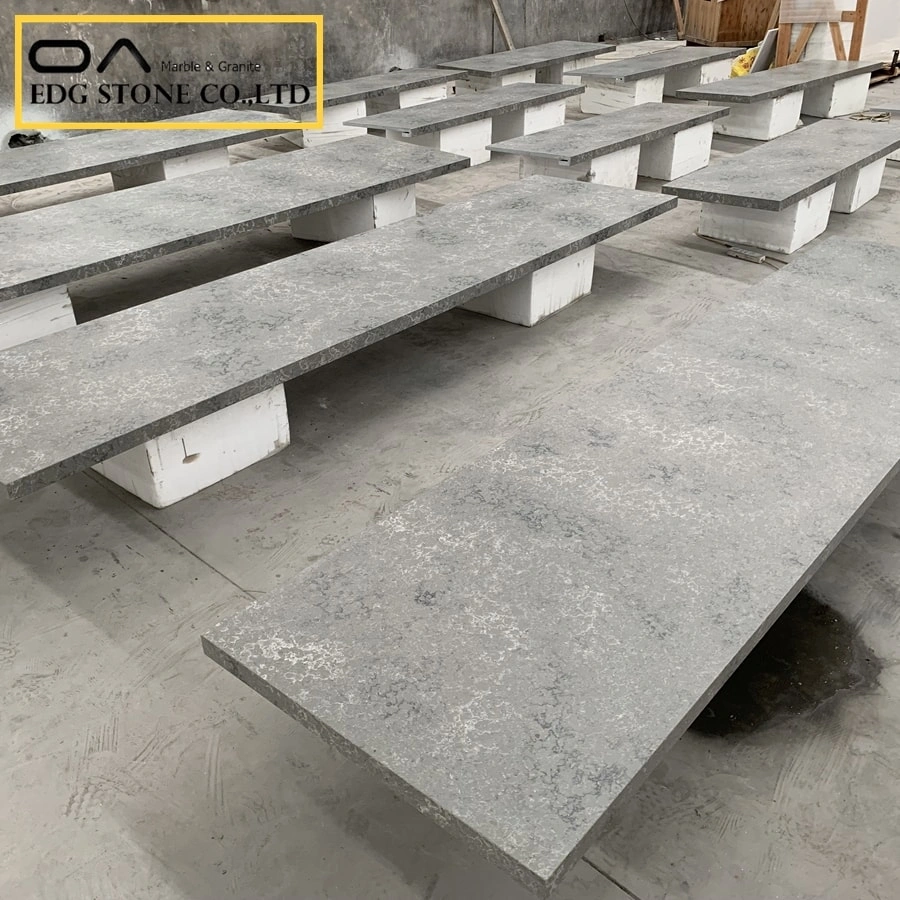In the cabinet structure, the most intimate contact with our imported food is the countertop. The durability and antibacterial properties of countertops directly affect our daily kitchen life, and more and more consumers are beginning to pay attention to the environmental protection and hygiene issues of countertops. So, what kind of countertop is more environmentally friendly? Let’s compare them carefully.
Natural marble has a natural texture but has cracks and defects. It is easy to crack. Natural marble has a variety of beautiful textures, but its natural fine cracks will appear after a long period of use. The cracks are difficult to wipe in daily cleaning, and it is inevitable that there will be some The residue is permanently filled into the cracks with the wiping of the rag and becomes a breeding ground for bacteria. Radiation that cannot be ignored Natural stone is more or less radiant, which may be harmful to human health.
Environmental protection index ★
Granite Natural material with good antibacterial properties
High density weakens the hidden worry of hiding dirt. As a traditional cabinet countertop material, granite has a high density, high hardness, and an abrasion-resistant surface, which reduces the possibility of hiding dirt to a certain extent.
Better antibacterial performance Tests have proved that among all the materials that can be used for kitchen countertops, granite has better anti-bacterial regeneration ability.
The limitations of natural materials The length of natural stone is usually not long, so if you want to make a full-length overall countertop, there must be seams, and these seams are also easy to hide dirt.
If you like natural materials very much, granite with strong antibacterial ability is an ideal choice, but you must pay special attention to the level of joints of the construction workers.
Environmental protection index ★★★
Stainless steel has the best antibacterial properties
Good antibacterial performance Tests have shown that among all the materials currently available for kitchen countertops, stainless steel ranks first in its anti-bacterial regeneration ability.
Easily injured appearance The stainless steel countertop has an avant-garde appearance, and it is shiny and not dirty. But once the countertop is scratched by a sharp tool, it will leave unrecoverable marks, and these fine scratches can easily hide dirt. You must pay special attention to the surface when you wipe it.
Environmental protection index ★★★★
Fire-proof board The joints of the section are not well bridged, mostly low-priced density board. The materials used in the manufacture of the fire-proof boards in China are mostly low-priced density boards, which cannot provide effective guarantees in terms of performance and environmental protection. Seamless splicing is difficult. Fireboard has the same length limitation as natural stone, and it is difficult to join the cross-sections. No matter whether it is glued with silica gel or caulked with metal strips, it is impossible to achieve perfect seamless splicing as a whole. These gaps are naturally a “hotbed” of bacterial contamination.
Environmental protection index ★★
Tiles are not easy to clean, and they are easily broken if they are too cold or too hot. Ceramic tiles used for cabinet countertops have the same physical characteristics as wall tiles. Although they are very durable, they are easily broken under the impact of heavy objects. The above can also damage it. There will definitely be gaps in splicing tiles. Even seamless tiles will leave a gap between bricks and bricks that is much larger than when splicing other materials. It is very inconvenient to clean, and the hidden sanitary hazards are self-evident, and the caulking agent is easy Darkened, mildew may also appear in poor quality.
Environmental protection index ★★
Artificial stone Economical and environmentally-friendly countertop, with a sense of stone material but no radiation. Artificial stone has rich textures and colors, which can be compared with stone, but it has no radiation and is easier to clean. It is an ideal substitute for natural marble. True seamless splicing Using unique bonding and polishing technology, artificial stone countertops can be seamlessly spliced, and there is no place for dirt and bacteria.
Environmental protection index ★★★★★
Eco-friendly countertop details, corners, and seams
The countertop of the cabinet must be connected to the cabinet body and to the wall. At this subtle connection, there are also health and environmental issues.
1. Environmentally friendly joint sealant, the joint between the countertop and the wall is generally bonded by a joint sealant, or a metal strip is used as a transition. It is recommended that you use a non-toxic and harmless water-soluble joint sealant.
2. Use environmentally-friendly decorative strips at the corners. At the corners where the corner countertops are spliced, silicone adhesives, plastics, and special metal strips are usually used for embedding to increase the appearance. Environment-friendly decorative strips and caulking agents made of a variety of colors of stainless steel and non-toxic polymer synthetic materials can make you enjoy a safe and hygienic kitchen life.
3. The putty that purifies the air, even if there is good ventilation, can not avoid the pollution of oil fume on the countertop. If you use advanced inorganic putty with an air purification effect, you can effectively remove indoor pollution and peculiar smell, convert these substances into carbon dioxide and water vapor and add cleaner and healthy air to the kitchen.
How to maintain cabinet countertops?
1. Keep the countertop as dry as possible. Refractory board and anti-folder countertops avoid long-term immersion in water and prevent the countertops from being deformed when they are opened. It is necessary to prevent the bleach and scale in the water from making the artificial stone countertops lighter and affecting the appearance.
2. Strictly prevent strong chemicals from contacting the countertop, such as paint remover, metal cleaner, stove cleaner, methylene chloride, acetone (nail polish remover), strong acid cleaner, etc. If you accidentally come into contact with the above items, immediately wash the surface with plenty of soapy water. If the nail polish is stained, wipe it with an acetone-free cleaning agent (such as alcohol), and then rinse with water.
3. Do not allow heavy or sharp objects to directly impact the surface; oversized or overweight utensils should not be placed on the table for a long time; nor should they be washed with cold water and immediately scalded with boiling water.
4. Use soapy water or ammonia-containing detergent (such as detergent) to clean. For scale, you can use a damp cloth to remove the scale and then wipe it with a dry cloth.
5. For knife marks, burn marks, and scratches, if the surface finish is required to be matte, use 400-600 grit sandpaper to polish until the knife marks disappear, and then use detergent and scouring pad to restore the original shape. If the surface finish is a mirror surface, first polish with 800~1200 grit sandpaper, then polish with polishing wax and wool polishing ring, and then clean the countertop with a clean cotton cloth. For small scars, wipe the surface with a dry cloth dipped in cooking oil.
6. There are many scratches on the countertop due to different reasons, or the appearance is affected by a long time of use (1~2 years), please professional and technical personnel for professional treatment.







